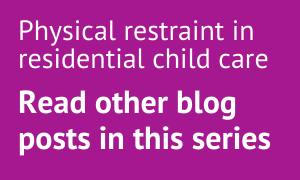Turning conversation into action

Over the past three weeks, we have been hosting a series of blog posts exploring one of the most complex and contentious issues in residential childcare: physical restraint.
Through these articles, people affected by physical restraint have shared and explored just some of the many perspectives and issues there are here. We have rightly been challenged to consider if there is any place at all for physical restraint in residential child care, and what the intended and unintended consequences of change within complex care settings could be: can we reduce or avoid the use of this practice through compassionate, individual approaches to loving, caring for and nurturing children and young people? And how can we better understand and respond differently to the pain and trauma children and young people communicate?
We have examined whether it is ever acceptable to work and practice in residential child care without thinking deeply in how to use intellect and join theory with practice; and thought about what support practitioners need to be able to do this. How can we ensure containment, regulation, protection and mutual respect, all within a complex context? The powerful questions in these blog posts have been met with equally powerful comments, some highlighting experiences that have been damaging and traumatic, some raising questions about systems and cultures, and, at the heart of this all, not losing sight that this is about how children and young people can be safely protected from harm.
It is with our gratitude to each and every contributor to the series and the subsequent discussions that we draw this to a close here, but this is not, and must not be, the end of the conversation. Despite the profound complexity, what is clear from this online conversation is the powerful will to create positive change in our approaches, and most importantly, in the experiences of those affected by physical restraint. This is indeed a watershed moment, in a context ripe for change. It is only by continuing to understand the complexities and diverse viewpoints that together the conversation can turn into effective action.
By no means have we uncovered all of the perspectives, and more needs to be heard. Addressing this means there also needs to be careful thought about what else needs to be known, and what else needs to happen in children’s houses, services, policies, and wider systems to ensure the eradication of the harm caused by physical restraint. This is the focus of the Scottish Physical Restraint Action Group going forward, and if you would like to find out more about how you can get involved, please email celcis@strath.ac.uk, putting ‘Scottish Physical Restraint Action Group’ in the subject line.
Please do keep on discussing these issues and commenting on the blog posts in this series. Your opinions and contributions continue to stimulate debate and enrich the collective understanding of this contentious issue in residential childcare practice, my deepest thanks for sharing them, and being a part of the conversation.
The views expressed in this blog post are those of the author/s and may not represent the views or opinions of our funders.
Commenting on the blog posts: sharing comments and perspectives prompted by the posts on this blog are welcome.
CELCIS operates a moderation process so your comment will not go live straight away.



